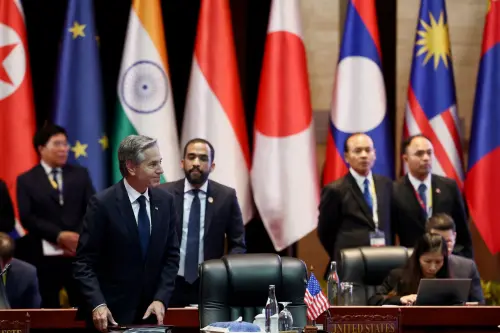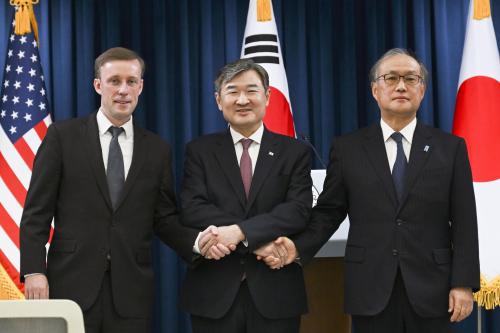The U.S.-Philippines alliance, rooted in the 1951 Mutual Defense Treaty (MDT), is a cornerstone of U.S. alliances and partnerships in Southeast Asia, a sub-region at the heart of the Indo-Pacific, America’s “priority theater.” The Philippines is important to U.S. interests. It sits at the crossroads of major sea lanes in the Indo-Pacific and is located close to Taiwan, which will make it particularly important in the event of a Taiwan contingency. The Luzon Strait, lying between Taiwan and Luzon, the northern portion of the Philippine archipelago, provides entrance to and exit from the South China Sea; its depth gives nuclear submarines a better chance of passing through undetected.
Of all the Southeast Asian countries, America’s strategic position is the strongest in the Philippines. Manila offers Washington the use of nine military facilities, which could be used in a fight against China. Minilaterals that include the Philippines, such as enhanced Japan-Philippines-U.S. security ties, and stronger bilateral ties between the Philippines and other U.S. allies, as exemplified by Japan and the Philippines’ Reciprocal Access Agreement in July, help create a latticework of “strong, resilient, and mutually reinforcing relationships,” an important U.S. National Security Strategy goal. Furthermore, the Philippines’ high-profile legal and physical clashes with China best showcase the U.S. narrative that China is flouting international law and that there is regional demand for the United States to counter this.
The alliance’s future will be shaped by the 2024 U.S. presidential election and the incoming administration’s foreign policy, especially toward Southeast Asia. A Harris administration is expected to reinforce alliances and emphasize human rights and democratic values. Insofar as reinforcing alliances includes that with the Philippines, bilateral ties will be strengthened; a focus on human rights could complicate relations given ongoing human rights concerns. A Trump administration might adopt a transactional approach, which could revisit past criticisms of allies “free-riding,” casting doubt on the U.S. commitment under the MDT and straining relations. But a hawkish Republican administration could also double down on defending the Philippines. Regardless of the election’s outcome, the U.S.-Philippines alliance will impact regional dynamics and great power competition.
The state of relations
U.S.-Philippines relations have generally been robust. The MDT was concluded five years after the United States granted the Philippines independence and is supplemented by the 1999 Visiting Forces Agreement and the 2014 Enhanced Defense Cooperation Agreement (EDCA). Since May 2023, the two countries have entered into further security and non-security arrangements and initiatives.
The Philippines’ security establishment and Filipino public opinion have facilitated strong ties. The Philippines is the largest country recipient of U.S. military assistance in the Indo-Pacific and relies on American support for various security issues, including countering separatist movements in the southern Philippines and addressing concerns in the South China Sea. In an annual survey of Southeast Asia this year, China, for the first time, edged past the United States as the region’s choice in the event that hedging was not possible, but the Philippines bucked the trend: 83.3% of Filipinos selected the United States, an increase of 4.5 percentage points over the preceding year.
That said, U.S.-Philippines relations have also seen low points, most notably in the early 1990s when Manila decided to close Clark Air Base and Subic Naval Base, which were among the largest and most strategically important U.S. military installations during the Cold War, particularly in the Asia-Pacific region. Relations were also poor during the presidency of Rodrigo Duterte when the president’s war on drugs and the Obama administration’s focus on human rights put Manila and Washington at loggerheads. The Duterte administration also initially sought closer ties with China at the expense of relations with America.
The Marcos administration has drawn a line under rocky relations. In February 2023, Manila added four EDCA sites to the five America already enjoys—of these, three are Taiwan-facing and the last faces the South China Sea. High-level meetings have also increased. Presidents Ferdinand Marcos and Joe Biden met in Washington in May 2023. In April 2024, the leaders of Japan, the Philippines, and the United States gathered in Washington for a historic summit. At the end of July, the Philippines and the United States held a 2+2 meeting of their foreign and defense ministers in Manila.
The Philippines’ security environment
Manila takes a dim view of its security environment. Relations with China deteriorated sharply after Beijing moved to take control of Scarborough Shoal in 2012, leading Manila to pursue an international arbitral case against China in 2013 for its maritime claims and actions in the South China Sea. Although Duterte attempted a rapprochement in pursuit of economic deals, and Marcos similarly sought better relations for stronger economic ties, relations with China remain fraught. Beijing has endeavored, though increasingly aggressive moves, to block Philippines resupply missions to Sierra Madre, a naval vessel Manila deliberately grounded in 1999 on Second Thomas Shoal.
On July 21, China and the Philippines reached a “provisional arrangement” on Manila’s resupply of daily necessities and rotation missions to Sierra Madre in Second Thomas Shoal. Neither side has released the text of this agreement so its details are unknown. Disagreement over its terms emerged soon after its announcement. Nevertheless, the Philippines carried out a “rotation and reprovisioning (RORE) mission” on July 27 without incident, though Manila on July 28 complained that Beijing had “mischaracterized” its RORE mission.
Whether the agreement holds will depend on whether it is premised on Manila’s intention to eventually tow away the Sierra Madre; whether Manila must inform Beijing prior to its resupply missions; whether Beijing has a right to inspect and monitor the resupply process; and whether Manila may send “construction materials to the warship and attempt to build fixed facilities or permanent outpost.” But the agreement’s longevity will ultimately depend on political will.
Manila is not just worried about physical clashes and the loss of territory or sovereign rights. At the Shangri-La Dialogue, an Asia-focused defense summit, Marcos highlighted concerns about the erosion of international law undermining countries’ agency, U.S.-China competition exacerbating flashpoints and constraining regional states’ strategic choices, and threats to the unity and centrality of the Association of Southeast Asian Nations (ASEAN).
The U.S. role in addressing the Philippines’ concerns
The Duterte administration showed disdain for the Philippines’ alliance with the United States and was wary of the MDT dragging Manilla into a war with China.
The Marcos administration, in contrast, has sought to bolster defense ties and lean on the MDT as a bulwark against aggressive Chinese actions in the South China Sea. In so doing, it is reverting to the Philippines’ traditional reliance on America as a security partner, which had been strained by Washington’s failure to respond after Beijing reneged on a deal the United States allegedly brokered for Chinese and Philippines vessels to withdraw from Scarborough Shoal in 2012. The Philippines withdrew its vessels in June 2012; China did not and instead established control of Scarborough Shoal.
Since then, America has taken important steps to demonstrate commitment. The Trump administration clarified that the MDT applies to the South China Sea; the Biden administration further clarified that it extends to an armed attack on the Philippine Coast Guard. But Washington will (rightly) not be drawn into identifying or confirming specific instances when the MDT might be triggered.
Issues to watch
In the run-up to the U.S. presidential election and into the new administration, China might further test the U.S. commitment under the MDT. Key questions include:
First, whether a willful act resulting in a (single) death would necessarily trigger the MDT. Second, whether a civilian death might trigger it, despite the MDT making no mention of civilians. When Marcos was asked whether a red line would be crossed if Chinese coast guard water cannons killed a Filipino sailor, and whether this would trigger Manila’s request to Washington to invoke the MDT, he appeared to respond affirmatively to both of these questions.
Third, whether Second Thomas Shoal constitutes island territory such that a Chinese move against it without an armed attack against Philippines (or U.S.) “armed forces, public vessels, or aircraft”—such as if the Sierra Madre became dislodged—would nonetheless trigger the MDT. The 2016 international tribunal ruling in the Philippines’ case against China held that Second Thomas Shoal is a “low-tide elevation” within the Philippines’ exclusive economic zone and therefore under its sovereign rights and jurisdiction; Second Thomas Shoal is thus not Filipino territory as such.
Fourth, given that the Sierra Madre might not last much longer, how might Manila continue to assert its sovereign rights over Second Thomas Shoal while being afforded potential MDT cover? A creative solution might be to (surreptitiously) drive a public drone boat aground on it. Finally, it must be asked whether a Chinese cyberattack against the Philippines would constitute an “armed attack.”
Even if the MDT is not technically triggered, failing to respond to egregious Chinese actions in the South China Sea could undermine the United States’ credibility with its allies and partners. Beijing’s escalation vis-à-vis the Philippines in the South China Sea is not simply a response to perceived unacceptable Filipino behavior, or even to test the boundaries of U.S. commitment to allies and partners, but also to chip away at American credibility.
Recommendations for the next administration
For the next administration to take strategic competition with China seriously, it must:
First, maintain strong U.S.-Philippines ties and prioritize this over any (specious) concerns about the Philippines “free-riding” under the MDT. Manila provides access to EDCA sites “without rental or similar costs” given the “mutuality of benefits” the agreement recognizes. The United States could, under the EDCA framework and in close coordination with Manila, potentially establish a resupply and re-arm facility for ships and submarines in the Philippines, which would provide a critical logistics hub for the U.S. Navy, allowing for quicker response times in the event of a conflict or crisis.
Second, restate that the MDT covers the South China Sea and an armed attack against the Philippine Coast Guard.
Third, ensure enhanced economic ties result in concrete outcomes. Beijing could still modulate Manila’s response by behaving better in the South China Sea, meeting its obligations under the Belt and Road Initiative (BRI)—China had repeatedly failed to act on funding requests under BRI deals with the Philippines—or offering up other investments.
Fourth, lower tensions around Second Thomas Shoal. As Brookings scholar Ryan Hass argues, America’s goals here must be “upholding the credibility of its alliance commitments, avoiding conflict with China, and preventing Chinese occupation of Second Thomas Shoal.” It is in America’s interest for the provisional deal around Second Thomas Shoal to hold.
Fifth, Washington might consider quietly signaling some of the MDT’s limits to Manila and concerned parties through non-official (Track II) channels. This would help preempt attempts to erode confidence in the United States’ reliability as an ally.
Sixth, privately but clearly communicate to Beijing, as the Obama administration is said to have done, that America will respond if Beijing builds infrastructure on Scarborough Shoal. Although Second Thomas Shoal has been the subject of international attention in the past year, escalation might also take place over other features. Beijing could build on Scarborough Shoal, a “rock” capable of an independent sovereignty claim, without triggering the MDT.1 Yet, as in the case of Second Thomas Shoal, a failure to respond would undermine U.S. credibility.
Finally, the Philippines is part of a wider ASEAN community and America must not neglect engagement with ASEAN and its member states, who are generally anxious about how Manila has gone head-to-head with China. Strong U.S. relations with ASEAN and its member states are important in and of themselves, but also for how they could factor into the Philippines’ considerations on positioning, even if they have not thus far been decisive. Given the uncertainty over U.S. foreign policy under a new administration, Manila may seek to avoid getting too far ahead of the ASEAN pack lest this leaves it entirely exposed to China.
-
Footnotes
- Sovereignty over Scarborough Shoal remains contested—the tribunal did not rule on it—and Beijing could potentially build on it without undertaking an “armed attack” given its control of the feature.
The Brookings Institution is committed to quality, independence, and impact.
We are supported by a diverse array of funders. In line with our values and policies, each Brookings publication represents the sole views of its author(s).





Commentary
The US-Philippines alliance and the 2024 US elections
September 16, 2024